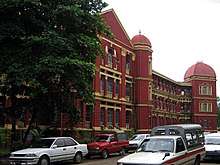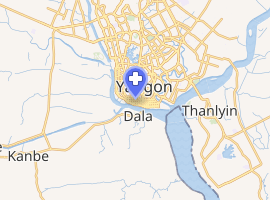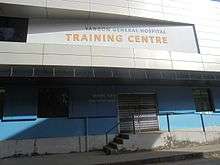Yangon General Hospital
The Yangon General Hospital (YGH, Burmese: ရန်ကုန် ပြည်သူ့ ဆေးရုံကြီး) is a major public hospital in a 14-hectare (35-acre) compound in Yangon, Myanmar. The 2,000-bed hospital consists of seven medical wards, three surgical wards, two trauma and orthopaedic wards, and 28 specialist departments for inpatient care.[2] The hospital also runs an ER for general medicine, general surgery and traumatology.[1][3]
| Yangon General Hospital | |
|---|---|
 | |

| |
| Geography | |
| Location | Lanmadaw 11131, Yangon, Yangon Region, Myanmar |
| Coordinates | 16°46′44″N 96°08′53″E |
| Organisation | |
| Type | Teaching |
| Affiliated university | University of Medicine 1, Yangon |
| Services | |
| Emergency department | Yes |
| Beds | 2000[1] |
| History | |
| Opened | 1899[1] |
| Links | |
| Website | yghhealthcare |
| Lists | Hospitals in Myanmar |
| Designations | |
|---|---|
History
.jpg)
Early history
In the early 1890s, the present site of Yangon General Hospital was then Agri-Horticultural Gardens and a Phayre Museum, had been scouted for relocation.[4]
The Yangon General Hospital was established in 1899 as the Rangoon General Hospital (RGH).
The main building was designed by then head of Public Works Department, Henry Hoyne-Fox, and construction started in 1904 and took five years to complete.[5] It was fitted with all the latest modern medical improvement at that time, including operating theatres with electricity and anesthesia rooms. The 3-story Victorian-style main building was opened on 6 May 1905.[6]
In the following year, the administrative block and other structures such as the Matron's accommodation and the morgue was added and cost four million rupees overall. In 1911, the new and larger hospital opened its doors for the first time with a total of 342 beds. It also housed the country's first bacteriological laboratory, though which several contributions to global medical science were made during the early 20th century.
World War II
During the Japanese Occupation, the Imperial Japanese Army occupied the building and reserved them for Japanese personnel and the General Hospital had to temporarily relocate to the former Diocesan Girls’ School on Signal Pagoda Road.
After World War II
After World War II, the hospital underwent renovations and had a capacity of 546 beds. In 1964, new specialist wards were added, and the capacity was increased to 1500 beds.[1]
The building was a major massacre site during the 8888 Uprising, in which injured patients, assumed to have taken part in the anti-government protests, were killed by the Tatmadaw. The hospital is closed to tourists. The hospital was also the site of Aung San Suu Kyi's first public speech, on 24 August 1988. The hospital was listed on the Yangon City Heritage List in 2017.[7]
Services and specialties provided
The hospital has around 2000 staffs to work around the clock to serve the long list of patients.[2] As of July 2018, the hospital has 2000 beds and generally treats 1800 inpatients and between 800 and 1200 outpatients a day.[8]
Although public health care is nominally free, in reality, patients have to pay for some medicine which are not provided by the Ministry of Health.
Departments
YGH maintains both medical and surgical specialist departments and diagnostic departments.[9]
Specialist departments
- Department of Cardiovascular Medicine (Ward 20)
- Department of Cardiovascular Surgery (Ward 19)
- Department of Clinical Haematology
- Department of Dermatology
- Department of Diabetes and Endocrinology (Ward 15+16)(Attached with General Medical Unit 2B (Ward 13+14))
- Department of Emergency Medicine
- Department of Anaesthesiology and Intensive Care Medicine
- Department of Hand and Reconstructive Microsurgery (Ward (3+4))
- Department of Neurology
- Department of Neurosurgery
- Department of Gastroenterology
- Department of Geriatrics (Ward 9+10)(Attached with General Medical Unit 3B (Ward 7+8))
- Department of Medical Oncology
- Department of Plastic, Maxillofacial & Oral Surgery
- Department of Physical Medicine & Rehabilitation
- Department of Radiation Oncology
- Department of Tropical and Infectious Diseases (Attached with General Medical Unit 1B)
- General Medical Units (1A, 2A (Ward 17+18), 3A (Ward 11+12)& 4)
- General Surgical Units (1, 2 & 3)
- Trauma care units (1 (Ward 1+2) & 2 (Ward 5+6))
- Intensive Care Cardiovascular Unit (Cardiac Intensive Care Unit and Coronary Care Unit (CCU)) (Ward 20)
- Diagnostic and Therapeutic Cardiovasular Catheterisation Laboratories
- Operation Theatre Complex
- Arrhythmias Clinic
- Special Skin Clinic
- STD Clinic
- National TB Programme
- Diabetic Clinic
- Dentistry Clinic
- Mental Health Clinic
- Acute Burn Care Unit
- Epilepsy Unit
- Isolation Ward
- Pain and Palliative Care Unit

Diagnostics departments
- Department of Radiology (MRI, 24 hr CT scan service, Xray, USS)
- Department of Pathology
- Department of Microbiology
- Department of Nuclear Medicine
- Diagnostic Cardiovascular Catheterisation Laboratories
- Non-invasive Cardiovascular Diagnostic Lab
- National Endoscopy Centre
- Neuroelectrophyisological Centre
Auxiliary departments
- Department of Forensic Medicine
- National Blood Bank
- Medical Record Department
- Bio-Medical Engineering Department
- Kitchen
- Laundry
- Motor Transport
Clinical training and nursing education
YGH, known for its Victorian-style architecture, with red brick and yellow-painted trimmings, is also the Tertiary Care Teaching Hospital of University of Medicine 1, Yangon, the Yangon Institute of Nursing, and the University of Medical Technology, Yangon.[1] YGH is the main teaching hospital of the University of Medicine 1, Yangon. It also trains nursing and medical technology trainees from the Yangon Institute of Nursing and the University of Medical Technology, Yangon.[10]
Research and other medical and academic collaborations
- Australia-Myanmar Trauma Management Program: The program activities for 2015 to 2017 was based on the delivery of trauma care team training to Myanmar clinicians.
See also
References
- "Yangon General Hospital". Yangon City Development Committee. Retrieved 2009-01-02.
- "Yangon General Hospital Updates". Myanmar Times. Retrieved 2016-06-15.
- "Yangon General Hospital". Surgical Implant Generation Network. Retrieved 2009-01-02.
- "19th Blue Plaque Yangon General Hospital | Yangon Heritage Trust". www.yangonheritagetrust.org. Retrieved 2018-07-06.
- "Yangon hospital is now a heritage building". The Myanmar Times. Retrieved 2018-07-06.
- "19th Blue Plaque Yangon General Hospital | Yangon Heritage Trust". www.yangonheritagetrust.org. Retrieved 2018-07-06.
- "Yangon General Hospital gets blue plaque for heritage status".
- "Illegal hawkers, squatters continue to plague hospital". The Myanmar Times. Retrieved 2018-07-06.
- "YGH Departments". Yangon City Development Committee. Retrieved 2009-01-02.
- "Teaching Programs at YGH". Yangon City Development Committee. Retrieved 2009-01-02.